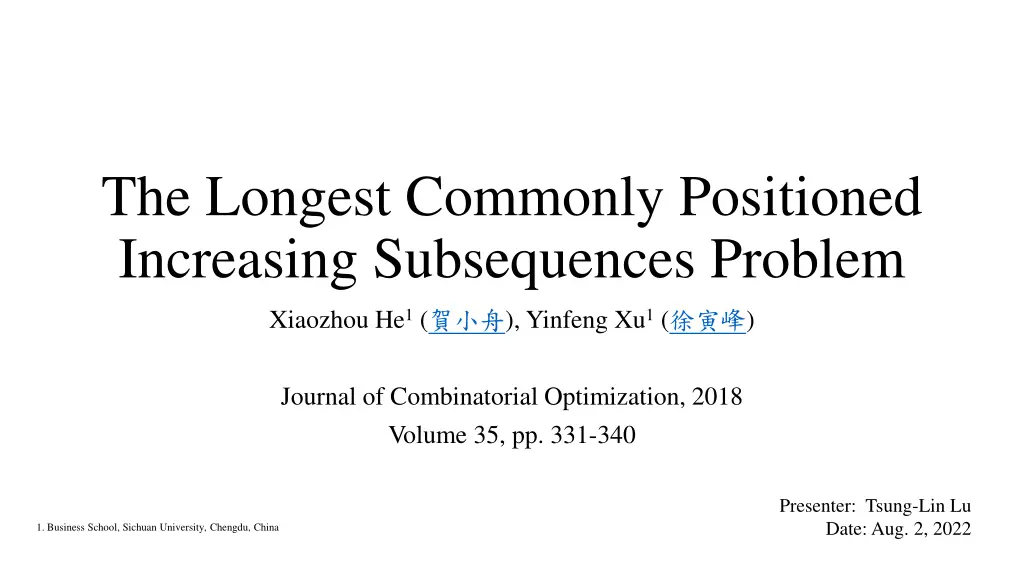
Longest Commonly Positioned Increasing Subsequences Problem Overview
Exploring the Longest Commonly Positioned Increasing Subsequences (LCPIS) problem, this research delves into finding subsequences where elements are commonly positioned in two input sequences. The study presents an algorithm with efficient time complexity and illustrates the relationship between LCPIS and LCIS problems.
Download Presentation

Please find below an Image/Link to download the presentation.
The content on the website is provided AS IS for your information and personal use only. It may not be sold, licensed, or shared on other websites without obtaining consent from the author. If you encounter any issues during the download, it is possible that the publisher has removed the file from their server.
You are allowed to download the files provided on this website for personal or commercial use, subject to the condition that they are used lawfully. All files are the property of their respective owners.
The content on the website is provided AS IS for your information and personal use only. It may not be sold, licensed, or shared on other websites without obtaining consent from the author.
E N D
Presentation Transcript
The Longest Commonly Positioned Increasing Subsequences Problem Xiaozhou He1( ), Yinfeng Xu1( ) Journal of Combinatorial Optimization, 2018 Volume 35, pp. 331-340 Presenter: Tsung-Lin Lu Date: Aug. 2, 2022 1. Business School, Sichuan University, Chengdu, China
Abstract (1/2) Based on the well-known longest increasing subsequence problem and longest common increasing subsequence (LCIS) problem, we propose the longest commonly positioned increasing subsequences (LCPIS) problem. Let ? = ?1, ?2, , ?? and ? = ?1, ?2, , ?? be two input sequences. Let ???? = ??1, ??2, , ??? be a subsequence of A and ???? = ??1, ??2, , ??? be a subsequence of B such that ??? ???+1, ??? ???+1 (1 ?<?) and ???and ???(1 ? ?) are commonly positioned (have the same index ?? = ??) in A and B respectively but these two elements do not need to be equal. 1
Abstract (2/2) The LCPIS problem aims at finding a pair of subsequences Asub and ???? as long as possible. When all the elements of the two input sequences are positive integers, this paper presents an algorithm with ? ?(? ?log? ?loglog? ?) time to compute the LCPIS, where ? = ???{???1 ? ???, ???1 ? ???}. And we also show a dual relationship between the LCPIS problem and the LCIS problem. 2
Outline Longest Commonly Positioned Increasing Subsequences (LCPIS) Algorithm Complexity LCPIS v.s. LCIS 3
Longest Commonly Positioned Increasing Subsequences (LCPIS) A = 1, 3, 6, 4, 5, 2, 5, 9, 7, 8 B = 2, 4, 3, 5, 3, 7, 2, 1, 6, 8 LCS (longest common subsequence): 4, 5, 2, 8 A = 1, 3, 6, 4, 5, 2, 5, 9, 7, 8 B = 2, 4, 3, 5, 3, 7, 2, 1, 6, 8 LCPIS: ???? 1, 3, 4, 7, 8 ???? 2, 4, 5, 6, 8 A = 1, 3, 6, 4, 5, 2, 5, 9, 7, 8 B = 2, 4, 3, 5, 3, 7, 2, 1, 6, 8 LCIS (longest common increasing subsequence): 3, 5, 7, 8 4
Algorithm (1/4) T1 (1, 2), (5, 2), (9, 1) A = 1, 3, 6, 4, 5, 2, 5, 9, 7, 8 B = 2, 4, 3, 5, 3, 7, 2, 1, 6, 8 LCPIS: ???? 1, 3, 4, 7, 8 ???? 2, 4, 5, 6, 8 Algorithm for LCPIS: vEB tree + dominance T2 (2, 7), (3, 4), (5, 3), (6, 3) T3 (4, 5) T4 (7, 6) query, insert and delete by vEB tree T5 (8, 8) binary search n pair of couple 5
Algorithm (2/4) Couple p couple couple 6
Algorithm (3/4) couple 7
Complexity vEB tree: 9
Abstract s 13
